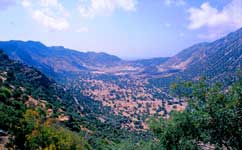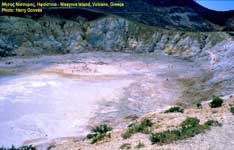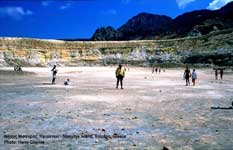.
Nisyros (Greek: Νίσυρος) is a volcanic Greek island and municipality located in the Aegean Sea. It is part of the Dodecanese group of islands, situated between the islands of Kos and Tilos. Its shape is approximately round, with a diameter of about 8 km (5 mi), and an area of 41.6 km2 (16.062 sq mi).[3] Several other islets are found in the direct vicinity of Nisyros, the largest of which is Gyali. The Municipality of Nisyros includes Gyalí (pop. 10) as well as uninhabited Pacheiá, Pergoússa, Kandelioússa, Ágios Antónios, and Stroggýli. It has a total land area of 50.055 km2 (19.326 sq mi) and a total population of 948 inhabitants. The island was also called Italian: Nisiro and Turkish: İncirli.
Geology
Stefanos, the largest crater of the volcano.
The island has a 3 kilometres (1.9 mi) to 4 kilometres (2.5 mi) wide caldera, and was constructed within the past 150 000 years, with 3 separate eruptive stages, ranging from explosive and effusive andesitic eruptions to effusive and extrusive dacitic and rhyolitic activity.[1] Its coasts are generally rocky or pebbled, but there are also a few sandy beaches (mainly in the northeastern part). The volcano is currently active (but not erupting), and fumaroles are found at the craters.[1] It has had four historical eruptions, all of which had a VEI of 2. Almost all of its eruptions involved phreatic activity.[2] The latest eruptive activity was a steam explosion in 1888,[1] after small ash eruptions in 1871 and 1873 and earthquakes are not infrequent. A period of seismic unrest in 1996-1997 led an international team of scientist to initiate monitoring of the volcanic unrest in the European Union sponsored Geowarn project. The entire volcanic complex includes the seafloor between Nisyros and Kos, the island of Gyali, and a part of Kos island.
Settlements
The island is reachable by ship from Pireaus and Kos, and in summer, there are many daily trips from the village of Kardamena on Kos. There is also a heliport. The main town and port of the island is Mandraki (pop. 682)(hole). Other villages are Paloi (167), Nikeia (48), and Emporios (25). According to a 2001 census, the municipality's resident population is 948 (including 10 on Gyali), although in summer it is augmented by many tourists as well as expatriate Nisyrians who visit the island for their vacations. Tourism is not so heavily developed as on other Greek islands. Deposits of perlite and pumice on Gyali provide much of the wealth of the island. The island used to be self-sufficient, and many crops were grown on its terraced slopes. Today, though, they are cultivated on a smaller scale.



History
According to Greek mythology, the island was formed when Poseidon cut off a part of Kos and threw it onto the giant Polyvotis to stop him from escaping. The ancient name of the Nisyros was Porphyris. Ancient walls, dating from the 5th century BC, part of the acropolis of the island, are found near Mandraki.
It was apparently also a source of millstones used in some of the earliest watermills, being referred to by epigrammatist Antipater of Thessalonica in the 1st century BC.[4]
Culture
Street in Mandraki
A traditional product of Nisyros is soumada, a non-alcoholic almond-flavoured drink. The patron saint of the island is Saint Nikitas. Many Orthodox Christian churches are found on the island, as well as four monasteries which are not inhabited by monks today, although various celebrations take place in them. The largest monastery is the one of Panagia Spiliani (Blessed Virgin Mary of the cave) at Mandraki. It is built beside the medieval castle erected by the Knights Hospitaller who conquered the island in 1315.
Twinning
Mandraki is twinned with the following municipalities:
Cyprus Lapithos, Cyprus
See also
List of volcanoes in Greece
List of traditional Greek place names
References
^ a b c d e "Nisyros: Summary". Global Volcanism Program, Smithsonian Institution.
^ a b "Nisyros: Eruptive History". Global Volcanism Program, Smithsonian Institution.
^ "City of Nisyros". Municipality of Nisyros. Retrieved 2008-01-22.
^ M. J. T. Lewis, Millstone and Hammer: the origins of water power (University of Hull Press 1997), pp. vii 66-7.
|
The Dodecanese Islands Agathonissi | Koubelonisi | Stroggyli | Farmakonisi | Arkoi | Kalovolos | Agreloussa | Anydros Patmou | Patmos | Hiliomodi Patmou | Tragonisi | Arefoussa | Leipsoi | Megalo Aspronisi Leipson | Makry Aspronisi Leipson | Kouloura Leipson | Makronisi Leipson | Halavra | Imia | Fragos | Arhangelos | Faradonesia | Leros | Piganoussa | Pitta | Megalo Glaronisi | Mikro Glaronisi | Kalymnos | Kalolimnos | Kalavros Kalymnou | Telendos | Nero | Safonidi | Plati Pserimou | Pserimos | Levitha | Mavra Levithas | Glaros Kinarou | Kinaros | Kos | Gyali | Nisyros | Pergoussa | Paheia Nisyrou | Kandeloussa | Tilos | Antitilos | Gaidourosnissi Tilou | Seirina | Mesonisi Seirinas | Adelfoi Syrnas Islets | Kounoupoi | Koutsomytis | Hondro | Astypalaia | Fokionissia | Pontikoussa | Symi | Nimos | Marmaras | Kouloundros | Plati Symis | Sesklio | Chalki | Agioi Theodoroi Halkis | Alimia | Makry Halkis | Prasouda | Rhodos | Strogulli Kritinias | Htenies | Karavolas Rodhou | Prasonissi Rodhou | Megalo Sofrano | Mikro Sofrano | Astakida | Kamilonisi | Saria | Karpathos | Kasos | Armathia | Makronissi Kassou | Rho | Kastellorizo (Megisti) | Stroggyli Kastellorizou |
| Ancient Greece
Science, Technology , Medicine , Warfare, , Biographies , Life , Cities/Places/Maps , Arts , Literature , Philosophy ,Olympics, Mythology , History , Images Medieval Greece / Byzantine Empire Science, Technology, Arts, , Warfare , Literature, Biographies, Icons, History Modern Greece Cities, Islands, Regions, Fauna/Flora ,Biographies , History , Warfare, Science/Technology, Literature, Music , Arts , Film/Actors , Sport , Fashion --- |
Retrieved from "http://en.wikipedia.org/"
All text is available under the terms of the GNU Free Documentation License



